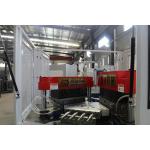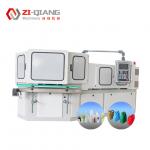1. Compact structural design, suitable for limited workshop space •
Integrated fuselage layout: The traditional separate "injection
unit", "blow molding unit" and "demolding unit" are integrated into
a compact fuselage (the length is 20%-30% shorter than traditional
equipment). For example, for injection blow molding machines that
produce products below 500ml, the entire machine can be controlled
to occupy an area of 8-10㎡ (traditional equipment requires 12-15㎡),
which is suitable for small and medium-sized factory workshops
(especially old factories with limited space planning). • Modular
assembly and convenient relocation: Core components (such as
injection molding system and clamping system) adopt "modular
design", which can be disassembled for transportation (the maximum
weight of a single piece is ≤3 tons), and can be assembled through
quick docking interfaces (such as hydraulic pipeline quick
connectors and circuit aviation plugs) (installation and debugging
time ≤8 hours, traditional equipment requires 1-2 days). For
enterprises that need to relocate factories, it can reduce the cost
of equipment disassembly and transportation (saving about 30% in
transportation costs).
2. Multi-functional integration to expand the application scenarios
of a single device • "Injection-Blowing-Cutting" integrated
molding: Some injection-blowing machines integrate "online
trimming/mouth trimming function" - after the product is formed,
there is no need to transfer it to a separate trimming machine. The
equipment's built-in "servo-driven cutter" (positioning accuracy
±0.1mm) can directly cut off excess burrs on the bottle mouth (such
as the burrs on the mouth of medicinal bottles). The flatness after
trimming is ≤0.05mm (meets sealing requirements), eliminating the
intermediate transfer link (the traditional process requires manual
transportation to the trimming machine, which is time-consuming and
easily causes product contamination). • Support for
two-color/multi-material composite molding: high-end injection-blow
molding machines can achieve "two-color injection-blow molding"
(such as transparent bottle body + colored bottle mouth logo) or
"multi-material composite" (such as inner layer PE anti-corrosion +
outer layer PP enhanced hardness) - through the dual barrel design
(independent temperature control), the two materials are injected
into the mold according to the preset ratio, and the composite
products (such as chemical reagent bottles, which require the inner
layer to be acid and alkali resistant and the outer layer to be
collision-proof) are formed in one time, without the need for
subsequent bonding process (the traditional process requires the
bottle body to be made first and then the bottle mouth to be glued,
which is prone to the risk of falling off).
3. Human-computer interaction optimization to reduce the operation
threshold and error rate • Visual operation interface and
fool-proof programming: equipped with a 10-15-inch touch screen
(supporting multi-touch), the operation interface adopts "icon +
Chinese guidance" design (such as the "mold adjustment" button with
mold schematic diagram, "parameter setting" divided into "novice
mode" and "expert mode"). In the novice mode, you only need to
enter the product weight and material type, and the system will
automatically recommend basic parameters (such as injection
temperature and blow molding pressure). The parameter adjustment
steps during mold trial are simplified from the traditional 10+
steps to 3-5 steps (the training cycle is shortened from 1 week to
2-3 days). • Safety protection and misoperation warning: The
equipment is equipped with an "infrared grating protection fence"
(response time ≤ 0.1 seconds). When the operator's limbs enter the
dangerous area (such as the mold opening and closing area), the
equipment will immediately stop and cut off the power source
(braking distance ≤ 5mm); at the same time, "double confirmation"
is set for key operations (such as modifying mold parameters and
manually opening the mold) (password entry + press the confirmation
key) to avoid accidental touch and damage to the mold (traditional
equipment only relies on emergency stop buttons, which has the risk
of misoperation).









